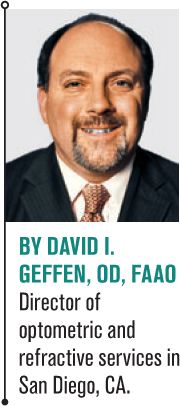What’s so special about specialty lenses?
Increasingly, many practitioners in today’s practices are using specialty contact lenses. These contact lenses historically have been viewed as hard to fit, difficult to find, and much higher in cost. Let’s look at what’s so special about specialty contact lenses.

Increasingly, many practitioners in today’s practices are using specialty contact lenses. These contact lenses historically have been viewed as hard to fit, difficult to find, and much higher in cost. Let’s look at what’s so special about specialty contact lenses.
Extended-range lenses
What determines that a lens is a “specialty” lens? There are many categories of these lenses and way too many to list every brand and manufacturer. The most common specialty lenses are the lenses which fall out of the parameters of normally available lenses in a category.
These would be lenses that are higher in spherical power than the company normally manufactures. Biofinity (CooperVision) is a typical lens in this category. Biofinity spheres are available from +6.00 D to -10.00 D-a very large range, which is good for the vast majority of patients. The Biofinity XR or extended range lens is now available from +15.00 D to -20.00 D.
Dr. Geffen: The value of a contact lens patient
Most doctors and manufacturers consider these extended-range contact lenses to be specialty lenses. These lenses allow us to serve the need of our patients who fall out of the normal parameter ranges. These are ordered and manufactured on an as-ordered basis at this time so you may need to wait up to a few weeks to receive these lenses.
There are also a number of smaller specialty lens companies that manufacture lenses on an as-needed basis. These companies have thrived in providing eyecare practitioners with lenses with most any power or base curve or diameter a patient may need. They also can get these lenses to patients in a few days.
Toric and multifocal lenses
Toric lenses are the next category of specialty lenses. Like spherical lenses, the major manufactures have a limited power range typically from +6 to -9 with 3 or for cylinder powers. The typical cylinder limit for readily available toric lenses is -2.25 D. Smaller labs are able to fill in the gaps and make a toric lens for our patients with almost any axis or power we need. These lenses are available in a few days to our patients.
Multifocal lenses are also available in many custom designs from small contact lens manufacturers. Some ingenious designs have come out of these labs and we can serve many more patients than ever before.
Lenses for irregular corneas
Now let’s cover some of the truly special designs coming out of smaller labs. Lenses for irregular corneas are changing the way we think about providing excellent vision and comfort to our patients. These lenses have provided a way for doctors to care for those patients who cannot or will not wear rigid gas permeable (RGP) lenses. Bausch + Lomb brought us the Kerasoft soft contact lens for irregular corneas. Kerasoft is available in a wide range of custom parameters and base curves to correct the irregularities in the cornea caused by keratoconus, surgical imperfections, and disease.
Dr. Geffen: R&D needed for new gas perm car systems, materials
Another lens in this category is NovaKone from Alden Optical, one of several specialty contact lens labs that have made great innovations in soft lens designs. NovaKone comes in any custom base curve you would like and has different center thickness parameters to correct for irregularities. There are several other lenses of these types from great-minded individuals creating new and improved contact lenses for every need.
What makes them special
So why are these lenses special? They seem to be treated as devices only certain doctors are allowed to use. They have a reputation as being difficult and eating up too much chair time for many doctors. However, because specialty lens companies are utilizing very advanced manufacturing processes, the reproducibility and quality has never been better. You can have the confidence that the patient will not be calling your office complaining about the lens. These lenses do take a little more time and thought.
Specialty contact lens company consultants are excellent partners in your practice-they want you to succeed and make it as easy as possible. The cost of the lenses is higher than standard lenses, and this is a concern for many doctors. Remember that these patients know that they are not the usual contact lens wearer and know that they have special needs. As such, they expect to spend more for both your expertise and the cost of the device.
Optometrists are notorious for not charging enough for our expertise and time. We need to be compensated for the extra knowledge and study we do to learn about these special lenses and the time we spend without patients.
So what is so special about specialty contact lenses? I can answer that question only one way. These lenses are so special because we are truly changing the life of patients who has sought our expertise to improve their quality of life!